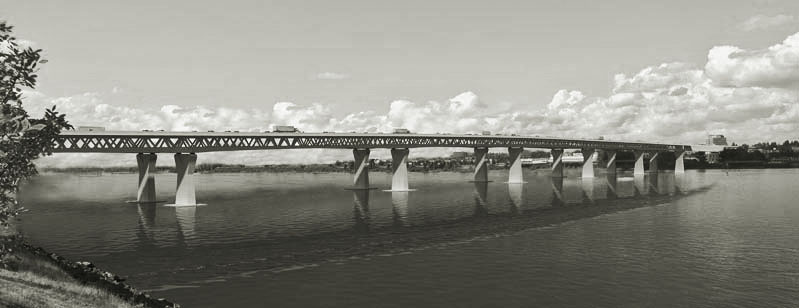The CRC is a cautionary tale about how we plan for, finance and invest in transportation infrastructure.

After nearly a decade of struggle — and the expenditure of $200 million in increasingly scarce public funds — the tragicomedy that has been the Columbia River Crossing appears to have finally drawn to a close. There hasn’t been a formal funeral, but it’s apparent the project is dead. Washington state left the project out of its new $12 billion transportation package, and former Oregon Gov. John Kitzhaber was similarly silent in his 2015-17 budget. Unlike her predecessor, new governor Kate Brown has not been an outspoken advocate for the project. And the Federal Transit Administration dropped the CRC from its list of candidate “new start” projects.
Before we turn our backs and walk away from this chapter of our history, it’s worth asking what lessons we should learn.
The collapse of the CRC isn’t just the story of a flawed project: It’s a cautionary tale about the systemic problems in how we plan for, finance and invest in transportation infrastructure.
First, a disclaimer: From 2008 onward, I made the following points repeatedly in public testimony to the legislature and other government forums. Far from disputing them, reports from the Oregon Department of Transportation (ODOT)confirm their accuracy.
The CRC expired in two steps: In 2013 the Washington legislature balked at its share of the project’s cost — $450 million, plus liability for revenue shortfalls and cost overruns — and in its short 2014 session, the Oregon legislature wisely chose not to saddle itself with the entire cost and risk of the multibillion-dollar project.
Some, notably the Seattle bureau chief for Bloomberg News, writing in December, claim that the implosion of the CRC signifies our failure to be able to do “big” things, like fix aging bridges. But the lesson from this epic failure is quite different.
If it had just been about “fixing” the I-5 bridge, the CRC might have moved ahead quickly and cheaply. But the project pushed by the two state DOTs was something else entirely: a 5-mile long, 12-lane-wide freeway that just happened to cross a river. The bulk of the project’s cost was not a mammoth new bridge, but rebuilding every intersection for miles north and south of the Columbia.
In the end, the project’s own technical studies showed it would be a transportation and fiscal disaster. The tolls needed to pay for the project would have to be far higher than originally suggested — $3.62 each way for cars and up to $13.00 for trucks — causing tens of thousands of cars to divert to an untolled I-205 crossing. The CRC’s numbers showed that the massive new bridge would handle fewer vehicles in 2035 than cross the existing bridge today. Meanwhile, I-205 would remain gridlocked. And based on experience with megaprojects elsewhere, we would have been saddled with billions in cost overruns and toll-revenue shortfalls.
All of this was forseeable and foreseen. The state DOTs postponed for years actually asking the Oregon and Washington legislatures for funding. The entire time they clung to outdated exaggerated traffic and financial forecasts. Car and truck traffic on the I-5 bridges has been going down and is now lower than it was a decade ago.
But although it is a real tragedy that we squandered $200 million and a decade on a project that never made economic or transportation sense, it would be a far worse tragedy if we failed to learn the lessons from this mistake.
Like the CRC, other major ODOT projects have experienced scope creep and cost overruns. Its current largest project, the 5-mile-long realignment of Highway 20 between Newport and Corvallis, has been delayed five years and is $300 million over its original budget.
ODOT has grown increasingly addicted to debt. In 2002, the agency devoted less than 2% of its state revenues to debt service. Since then, it has bonded the bulk of new revenue to generate money for new capital projects. The political appeal of this spend-now, pay-later approach is undeniable. But coupled with revenues that have fallen $500 million below projections over the past five years, ODOT now spends roughly a third of its state revenue paying off debt on past projects.
The temptation to pursue high-profile new construction projects politically trumps the task of filling potholes and repaving. In fact, the maintenance backlog is used as a kind of “bait and switch”: We are reminded that maintaining deteriorating pavement is far cheaper than replacing it. But when new funding is made available, it is used to pay for big new projects. The state’s initial share of the CRC was to be paid for by a 20-year lien on state gas tax revenues — which would have further worsened the maintenance shortfall.
In the mid-1970s, Portland scrapped the equally misguided plan to build the Mount Hood Freeway. Instead it began investing in transit and reviving central-city neighborhoods. Neighborhoods that were in the path of the planned freeway are some of the city’s hottest, and Portland has steadily reduced per-capita driving — and the amount of money it exports to carmakers and oil producers.
For too long, we built highways with little thought to how they would affect our communities and our future budget. But for good economic, fiscal and environmental reasons, that era is at an end. We need to shift our focus to maintaining what we have: “Fix it first” and least-cost planning should be the order of the day. Frugal repairs rather than extravagant replacements will make our limited resources go further.
It’s arguable that we don’t have enough money to maintain the road system we’ve already built. But until we reform our current system for planning and prioritizing investments, there’s little reason to think Oregon will get real value for putting more money into its transportation system.
- Joe Cortright is a principal economist for Impresa, a Portland consulting firm.

